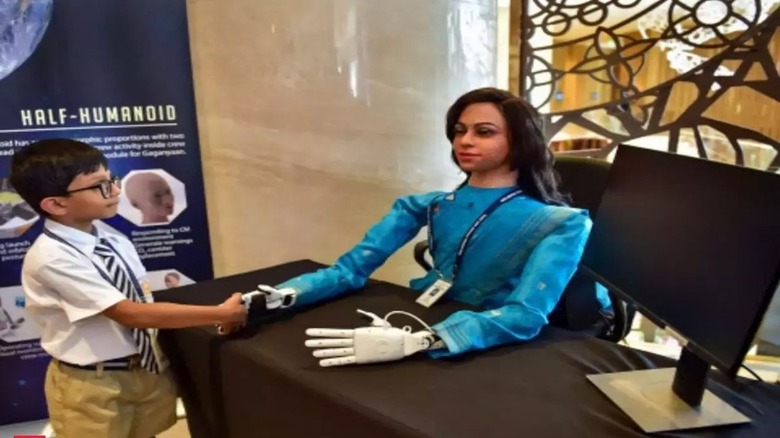Vyommitra Is The Humanoid Robot India Is Sending To Space
The country of India is the world's second most populated at 1.417 billion, right behind China with 1.426 billion. It's the seventh largest by land mass and has the fifth largest economy. Yet, when you think of countries with a burgeoning space agency, India is not one that immediately springs to mind.
However, in 2008, the Indian Space Research Organization (ISRO) sent a lunar orbiter called Chandrayaan-1 to the Moon. It was India's first foray into space, let alone to Earth's closest celestial body. Its mission was to observe, map, and study chemicals, minerals, and geology on the Moon's pockmarked skin. While in orbit, it launched a 64-pound probe that smashed into the surface, and its findings eventually revealed the presence of water molecules on the Moon. The ISRO lost contact with Chandrayaan-1 in 2009, and the orbiter was deemed lost.
In the intervening decade, the ISRO worked to gett back to the Moon, and in 2019 sent its Chandrayaan-2 hurtling toward the South Pole. India was hoping to become only the fourth country to land on the Moon and the first to attempt a South Pole landing. Interestingly, all prior moon landings occurred within a 30 to 40-degree arc north or south of the Moon's equator. Once in orbit, it sent a robotic lander named Vikram down to the surface. Moments before it touched down, something happened with the braking thrusters, and it crashed. Chandrayaan-2 is still orbiting the Moon, collecting data to this day.
One small step for humanoid robots...
Undeterred, ISRO began preparing for another shot at the Moon's south pole with Chandrayaan-3, but as part of a broader mission with bigger goals. The Gaganyaan project is India's primary mission to finally get its astronauts into outer space. In 2020, ISRO revealed that while Chandrayaan-3 would be unmanned, it would include something ... not quite human.
Enter Vyommitra ("vyoma" means space in Hindi, "mitra" means friend), a female-looking humanoid robot that will "pilot" Chandrayaan-3 when it launches. By using Vyommitra in place of an actual person, ISRO means to test out the suitability of a spacecraft that future real human Vyomanuats (Indian astronauts) will encounter. Vyommitra has an upper torso complete with moveable head, face, lips, arms, hands, and fingers, but no lower body. She can perform life support operations, mimic crew activities, talk with astronauts (in two different languages), and even answer questions as if it were a fellow crew member. The ISRO Inertial Systems Unit (IISU) designed and created the robot while ISRO worked on Vyommitra's fingers.
Recently, "The Hindu" reported that artificial intelligence had successfully been merged with the body so that it could actually understand what was being displayed on the vehicle's control panels, flip switches accordingly, and talk directly to ISRO ground control. "It has a certain level of intelligence. What we intend is that it should operate and read the display panels and communicate back to us using its own voice," said IISU director Sam Dayala Dev.
Chandrayaan-3 was initially scheduled for a December 2020 launch, but like many space flights, it has been repeatedly scrapped and rescheduled. The latest information states that Chandrayaan-3, with Vyommitra aboard, will launch in August 2023.
